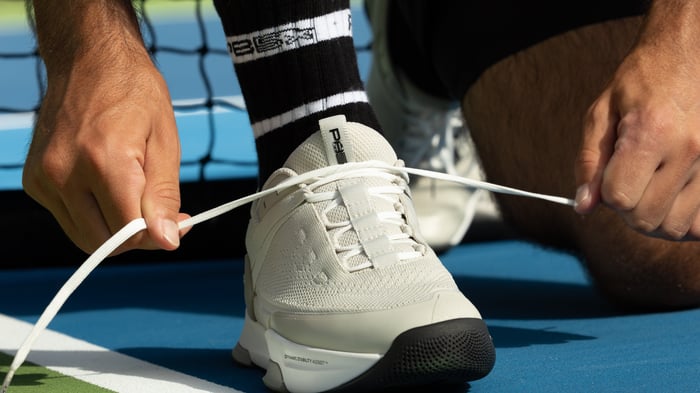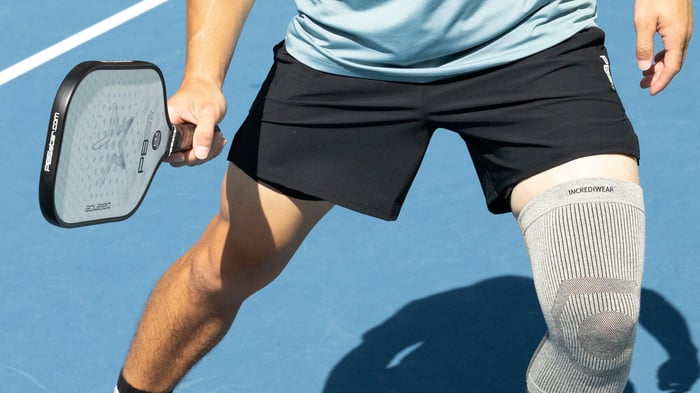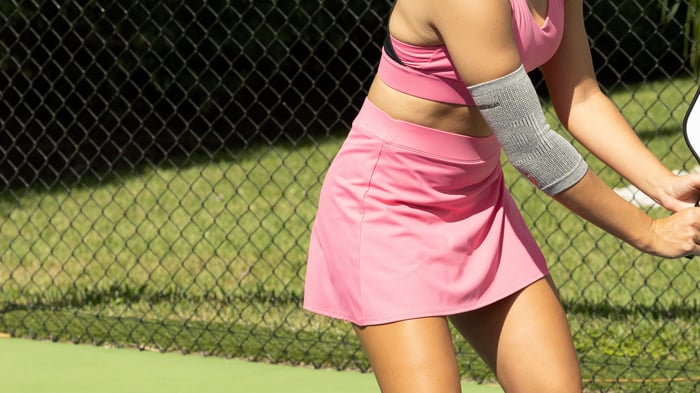Key takeaways:
Pickleball-specific fitness routines are essential for improving explosive power, agility, and endurance, giving players a competitive edge on the court.
Targeted exercises like dynamic warm-ups, core strength training, and agility drills help prevent common injuries and enhance overall performance.
Incorporating sport-specific conditioning into your routine not only boosts your game but also ensures longevity and reduces injury risks for players of all levels.
Pickleball’s explosive growth has brought with it a new wave of highly competitive players. But here’s what many don’t realize: the leap from good to great isn’t just about perfecting your third shot drop or mastering the kitchen game. While you’re drilling serves and fine-tuning your strategy, your toughest competitors are gaining an edge through focused fitness training; building speed, power, and endurance in ways most recreational players never even consider. The real secret is understanding that pickleball demands sport-specific conditioning, and it’s something far too many players overlook.
Top-level competitors know that generic gym workouts aren’t enough when you need explosive lateral movement, lightning-fast reflexes, and the stamina to stay sharp through a grueling three-set match. The most effective training blends strength work for crushing overheads with agility drills that let you cover every inch of the court. That’s why this guide dives into six targeted pickleball fitness routines designed for the unique demands of competitive play, covering everything from dynamic warm-ups that prime you for intense rallies to recovery strategies that keep you injury-free and ready for the next challenge.
Our performance-ready apparel is built to support every stage of your training journey, giving you the comfort, confidence, and mobility to push harder and play better. So, if you’re ready to train like a champion and join a community that values progress both on and off the court, let’s get started.
Why pickleball-specific fitness routines matter
A lot of competitive players assume that being in good general shape will automatically translate to better performance on the court. But pickleball isn’t just about general fitness; it demands a unique blend of explosive power, lateral quickness, and sustained focus that traditional workouts rarely develop. The game’s stop-and-go rhythm, with quick bursts of movement followed by short recovery periods, puts your body under very different demands than steady-state cardio or basic strength training. While a regular gym routine might boost your overall health, it won’t fully prepare you for the rapid direction changes, split-second reactions, and repeated overhead swings that define competitive play.
That’s where pickleball-specific fitness comes in. These tailored programs train the exact movement patterns you’ll use in matches, building the explosive lateral speed to reach wide shots, the core stability for driving powerful cross-court shots, and the quick recovery to stay sharp through long rallies. Players who commit to this kind of training often notice fewer overuse injuries like pickleball elbow or knee strain, better endurance during tournaments, and a real competitive edge that can mean the difference between holding your own and dominating the match.
#1. Start strong with a dynamic warm-up for pickleball
Before you step onto the court for intense play, your body needs the right kind of preparation, and that means a dynamic warm-up tailored for pickleball. Unlike static stretching, which can actually limit strength and power, dynamic movements raise your body temperature, wake up your muscles, and prime you for the explosive demands of the game.
Forward lunges with rotation warm up your legs and core together, getting you ready for the twisting motions in cross-court shots and defensive plays.
Lateral lunges and shuffles activate the muscles you need for quick side-to-side movements, mimicking the court coverage you’ll rely on in matches.
Leg swings and high knees loosen up your hips and engage your hip flexors, giving you the range and power to chase tough shots.
Arm circles and shoulder rolls prep your shoulders for smashes and repetitive paddle swings, helping prevent strain during long games.
Gentle wrist circles engage the smaller joints that control paddle handling, so you start every match with better touch and control.
By making dynamic warm-ups a habit, you’ll not only lower your risk of injury but also start every match sharper and more prepared.
#2. Build your foundation with core strength exercises for pickleball
Your core is the engine behind every powerful shot and quick change of direction. A strong, stable core improves balance, rotational power, and shot control; three things you can’t play at a high level without.
Planks and variations build deep stabilizers that keep your spine aligned through rapid movements, while Russian twists develop the rotation strength you need for cross-court drives and defensive pickups. Medicine ball slams mimic the forceful motions of overheads, training your body to generate power from the center out. Glute bridges strengthen the link between your core and lower body, improving balance and weight transfer for quick positioning.
Adding targeted core training into your routine pays off fast. You’ll notice better shot stability, more consistent placement under pressure, and less fatigue in tournament play.
#3. Sharpen your movements with agility drills for quick footwork
Fast, efficient footwork is what separates competitive players from casual ones. Agility drills sharpen your ability to react instantly, change direction smoothly, and stay balanced during high-speed rallies.
Ladder drills build quick foot turnover and precise step patterns for net exchanges.
Lateral shuffle drills strengthen side-to-side speed for wide shots.
Cone weaving improves directional changes while staying in control.
Forward and backward sprints sharpen your ability to transition between offense and defense.
Box drills combine multiple direction changes to mimic real match situations.
Plyometric jumps develop explosive leg power that translates to faster coverage and more dynamic shots.
#4. Boost your shots with upper-body power training
Strong arms alone don’t win points; explosive, coordinated upper body strength does. Power in your serves, drives, and smashes comes from training multiple muscle groups to fire together.
Medicine ball throws build raw serving power, while diagonal theraband pulls strengthen the exact muscles used in forehand and backhand strokes. Push-ups create a strong base for overheads, and banded overhead flexion keeps shots steady under pressure. Chest presses add forehand force, and lawnmower rows strengthen the back and obliques for better posture and shot execution. With just 4–6 weeks of consistent training, most players see noticeable gains in shot speed and consistency.
#5. Strengthen your base with lower-body strength routines
Your legs and hips are the foundation for every move on the court. Lower-body training builds the strength, endurance, and explosiveness needed for quick reactions and strong positioning.
Squats and goblet squats strengthen your main leg muscles for powerful starts and stops.
Split squats and lunges improve balance and unilateral strength for off-center shots.
Calf raises boost your push-off power for sprints.
Plyometric jumps teach your muscles to generate force fast.
Single-leg exercises enhance balance for shots under pressure.
Progressive overload training keeps your legs strong through long matches, reducing fatigue errors.
#6. Boost your stamina with pickleball-specific endurance workouts
Pickleball matches test both your body and mind. Endurance training keeps you sharp from the first serve to match point, especially in tournaments where recovery time is short.
HIIT workouts mimic the fast-paced bursts of rallies with short recovery periods.
Court sprint intervals train your muscles for the real movement patterns of competitive play.
Circuit training blends cardio and functional strength for all-around stamina.
Plyometric endurance builds repeatable explosive movements for the entire match.
Continuous rally simulations train your body and mind to sustain strategy under fatigue.
Recovery intervals improve how fast you bounce back between intense points.
By targeting the same movement patterns and energy systems you use in competition, these routines help you stay powerful, quick, and mentally sharp all the way through match day.
Ready to play better? Join the PB5star community
The eight targeted fitness routines you’ve just learned are your blueprint for taking your game to the next level, but true competitive success comes from pairing your training with gear that works as hard as you do. As pickleball continues its rapid rise, with participation up 40% from 2019 to 2021, serious players know that specialized apparel and footwear aren’t just extras; they’re performance multipliers.
When you commit to structured training, you deserve a community that shares your drive for improvement. PB5star brings together competitive players who understand that performance and confidence go hand in hand. Explore our exclusive collection of high-performance gear designed for athletes who refuse to settle for average, and see how the right equipment can elevate not just your play, but your entire competitive mindset.
FAQs
What gear or equipment is best for these exercises?
The right gear can make all the difference in your training, and it starts with court-specific footwear. Our PB5 Court2 shoes are built for pickleball with Dynamic Stability Assist™ technology for superior lateral support, giving you the stability and confidence to power through agility drills and quick directional changes without risking injury. Pair them with simple, versatile tools like resistance bands for strength work, a medicine ball for power training, and an agility ladder for sharper footwork. Quality gear that fits well not only boosts performance but also protects you during the explosive, fast-paced movements that define competitive play.
Can these routines help reduce my risk of common pickleball injuries?
Targeted fitness routines directly address the movement patterns and muscle imbalances that lead to common pickleball injuries, with injury prevention strategies reducing your risk of knee strains and shoulder problems. The core strength exercises and mobility work specifically target the stability and flexibility needed to handle the sport's unique demands. With more than 36.5 million people playing pickleball, proper conditioning becomes even more important for staying healthy in this rapidly growing sport.
How do I modify these routines for different skill levels?
Beginners should start with bodyweight versions of strength exercises and focus on mastering proper form before adding resistance or complexity. Advanced players can increase intensity through heavier weights, faster movement patterns, and longer endurance intervals that challenge their competitive fitness levels. The key lies in progressive overload; gradually increasing difficulty as your body adapts to each training stimulus.








